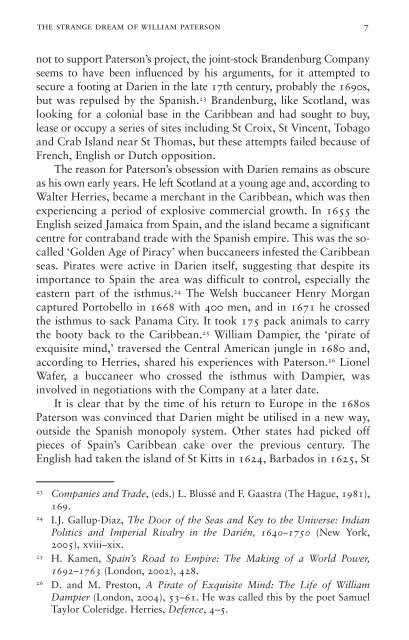Create successful ePaper yourself
Turn your PDF publications into a flip-book with our unique Google optimized e-Paper software.
<strong>Price</strong> <strong>of</strong> <strong>Scotland</strong> B format_Layout 1 03/11/2020 11:09 Page 7<br />
the strange dream <strong>of</strong> william paterson 7<br />
not to support Paterson’s project, the joint-stock Brandenburg Company<br />
seems to have been influenced <strong>by</strong> his arguments, for it attempted to<br />
secure a footing at Darien in the late 17th century, probably the 1690s,<br />
but was repulsed <strong>by</strong> the Spanish. 23 Brandenburg, like <strong>Scotland</strong>, was<br />
looking for a colonial base in the Caribbean and had sought to buy,<br />
lease or occupy a series <strong>of</strong> sites including St Croix, St Vincent, Tobago<br />
and Crab Island near St Thomas, but these attempts failed because <strong>of</strong><br />
French, English or Dutch opposition.<br />
<strong>The</strong> reason for Paterson’s obsession with Darien remains as obscure<br />
as his own early years. He left <strong>Scotland</strong> at a young age and, according to<br />
Walter Herries, became a merchant in the Caribbean, which was then<br />
experiencing a period <strong>of</strong> explosive commercial growth. In 1655 the<br />
English seized Jamaica from Spain, and the island became a significant<br />
centre for contraband trade with the Spanish empire. This was the socalled<br />
‘Golden Age <strong>of</strong> Piracy’ when buccaneers infested the Caribbean<br />
seas. Pirates were active in Darien itself, suggesting that despite its<br />
importance to Spain the area was difficult to control, especially the<br />
eastern part <strong>of</strong> the isthmus. 24 <strong>The</strong> Welsh buccaneer Henry Morgan<br />
captured Portobello in 1668 with 400 men, and in 1671 he crossed<br />
the isthmus to sack Panama City. It took 175 pack animals to carry<br />
the booty back to the Caribbean. 25 William Dampier, the ‘pirate <strong>of</strong><br />
exquisite mind,’ traversed the Central American jungle in 1680 and,<br />
according to Herries, shared his experiences with Paterson. 26 Lionel<br />
Wafer, a buccaneer who crossed the isthmus with Dampier, was<br />
involved in negotiations with the Company at a later date.<br />
It is clear that <strong>by</strong> the time <strong>of</strong> his return to Europe in the 1680s<br />
Paterson was convinced that Darien might be utilised in a new way,<br />
outside the Spanish monopoly system. Other states had picked <strong>of</strong>f<br />
pieces <strong>of</strong> Spain’s Caribbean cake over the previous century. <strong>The</strong><br />
English had taken the island <strong>of</strong> St Kitts in 1624, Barbados in 1625, St<br />
23<br />
Companies and Trade, (eds.) L. Blussé and F. Gaastra (<strong>The</strong> Hague, 1981),<br />
169.<br />
24<br />
I.J. Gallup-Diaz, <strong>The</strong> Door <strong>of</strong> the Seas and Key to the Universe: Indian<br />
Politics and Imperial Rivalry in the Darién, 1640–1750 (New York,<br />
2005), xviii–xix.<br />
25<br />
H. Kamen, Spain’s Road to Empire: <strong>The</strong> Making <strong>of</strong> a World Power,<br />
1692–1763 (London, 2002), 428.<br />
26<br />
D. and M. Preston, A Pirate <strong>of</strong> Exquisite Mind: <strong>The</strong> Life <strong>of</strong> William<br />
Dampier (London, 2004), 53–61. He was called this <strong>by</strong> the poet Samuel<br />
Taylor Coleridge. Herries, Defence, 4–5.


















